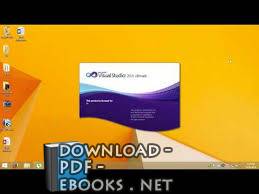

❞ كتاب INTRODUCING VISUAL S TUDIO 2010 ❝
INTRODUCING VISUAL STUDIO 2010
DAVID CHAPPELL
2
CONTENTS
Tools and Modern Software Development
3
Understanding Visual Studio 2010
3
The Components of Visual Studio 2010
...
4
A Closer Look at Team Foundation Server
5
Work Item Tra
cking
7
Version Control
....
8
Build Management: Team Foundation Build
9
Reporting and Dashboards
9
Using Visual Studio 2010
12
Managing Requirements
12
Architecting a Solution
13
Designing Code: UML Modeling
........
14
Controlling Code: Layer D
iagrams
14
Understanding Code: Sequence Diagrams and More
15
Writing Code
16
Supporting Software Development
...
17
Supporting
Database Development
..
18
Supporting Developer Testing and Debugging
19
Working with Project Information
....
20
Testing Code
20
Gathering Test Results and Diagnostic Data
21
A Tool for Testers: Microsoft Test Manager 2010
23
Managing Test Lab VMs: Visual Studio Lab Management 2010
....
24
Putting the Pieces Together: A Testing Scenario
25
Supporting Manual Testing
27
Supporting Automated Testing
28
Managing and
Tracking a Project
30
Maintaining Code
32
Adopting Visual Studio 2010
34
Deciding What to Buy
34
Migration: Getting There From Here
36
Conclusion
36
About the Author
36
3
T OOLS AN D
MODERN S OFT WARE
DEVELOPME N T
For most people, the days of the lone developer are long gone.
The great majority of software today is
created by
teams.
Given this reality,
modern software development
to
ols are used primarily by
people
working together
.
One approach to designing
these
tools is to create a separate tool for each part of the
development
process. Everyone on the
team might
then
agree to use a particular
tool for versioning source code,
ano
ther for tracking bugs, and a third for managing tests. This approach can certainly work
—
it’s much
better than having no tools at all. But what happens when
a developer needs to determine which test
found a particular bug in
code that addresses a specific
requirement
?
Or what if a project manager wants
to get a view of the project’s overall code quality over time, looking at bug counts, test progress, code
churn, and more?
Answering these kinds of questions requires integration across the team’s tool
set.
Even
though each tool might be great at what it does,
development with
a set of disconnected
tools
has limit
s
.
An alternative
approach is
to
create
an integrated set of
development
tools
explicitly designed
to
work
together
. While a
particular
member of th
is tool set might not have every feature found in a standalone
version of that tool, the connections between the tools let the team work more effectively.
Answering
questions that span tools gets easier
, as does handing off work between different team memb
ers
.
S
ince
the goal is to optimize the development process as a whole,
this integrated approach can make
the
process of creating software
significantly
more effective.
Achieving
this is the goal of
Visual Studio 2010. This latest release of Microsoft’s fl
agship development
environment aims at providing a unified set of tools for a variety of development needs. The intent is to
be useful in a range of situations, from a large development team spread across three continents
to
a
solo
developer working on her
own
.
It’s meant to be
a
modern foundation for what’s become known as
Application Lifecycle Management (ALM)
.
Visual Studio 2010
is the successor to both Visual Studio 2008 and Vi
sual Studio Team System 2008.
(
Microsoft chose to drop the
“Team System” labe
l
with this release
.
)
The product
is large, and so it’s
available
in
several different configurations, each with a specific set of functionality.
How those
configurations look and what’s in each one
is described at the end of this paper. The goal now is to
describe
Visual Studio 2010
as a whole, painting the big picture of what this technology family is and how
it can be used.
UN DERST AN DI NG
VI SUAL ST UDI O 2 0 1 0
Modern software development is anything but simple. Accordingly, the tools that support today’s
dev
elopment teams
have
many
moving parts
, and Visual Studio 2010 is no exception. One way to get a
handle on this
product family
is to
start with a broad look at the components and how they fit together
.
Once we’ve done this, we can look more closely at the
p
iece
that ties everything else together: Team
Foundation Se
-
من كتب فجوال بيسك دوت نت كتب لغات البرمجة - مكتبة كتب تقنية المعلومات.



 قبل تحميل الكتاب ..
قبل تحميل الكتاب .. 

 منصّة المكتبة
منصّة المكتبة